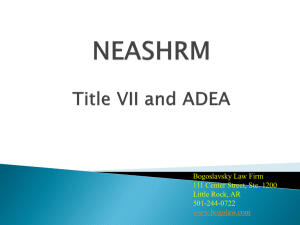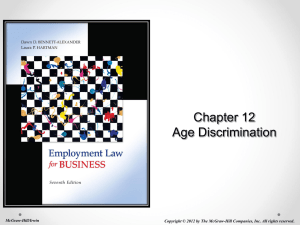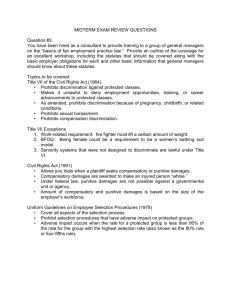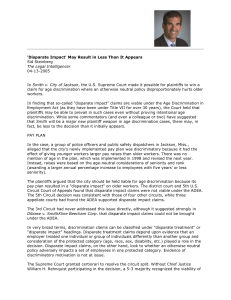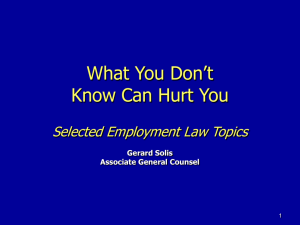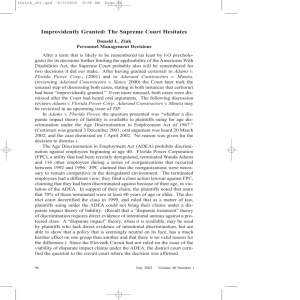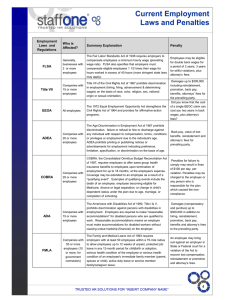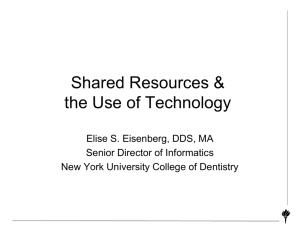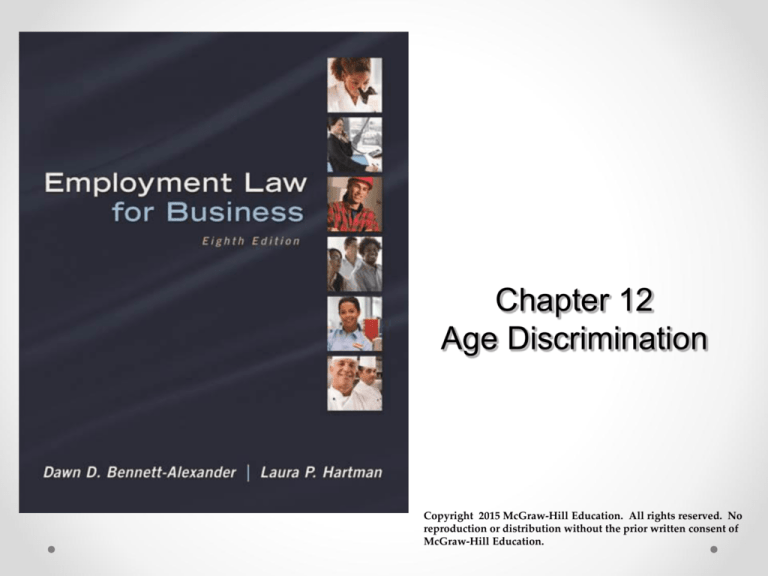
Chapter 12
Age Discrimination
Copyright 2015 McGraw-Hill Education. All rights reserved. No
reproduction or distribution without the prior written consent of
McGraw-Hill Education.
Learning Objectives (1)
Distinguish the perception of older workers from
the reality of their impact in the workplace
Describe the history of protecting older workers
in the United States, and its conflicting goals
Distinguish the ADEA and state-based age
discrimination laws
Identify the legal options available to an
employee who believes that he or she is a victim
of age discrimination
12-2
Learning Objectives (2)
Explain the prima facie case of discrimination
based on age
Describe the bona fide occupational qualification
defenses available to employers under the
ADEA
Distinguish circumstances where disparate
impact and disparate treatment apply in
connection with age discrimination
12-3
Learning Objectives (3)
Analyze factual circumstances when employer
economic concerns may justify adverse action
against particular groups of workers
Recognize necessary elements to establish
pretext under the ADEA.
Define the parameters of a valid waiver of ADEA
rights
12-4
Age Discrimination Context (1)
American, other cultures value youth
Perceptions of older workers may not match
evidence: reliability, effort, attendance
Tech industry in particular faces challenges to its
ageist culture
Zuckerberg quote, Google settlement
55+ workforce grew from 12-22% from 19922012; projected to be 26% by 2022
12-5
Age Discrimination Context
(2)
Trend for workers to remain employed longer, for
economic and cultural reasons
Talent retention and utilization challenges
Research suggests experience may be undervalued asset
Generalizing/stereotyping constitutes wrongful
discrimination
Essence of anti-discrimination law is individualized
consideration
12-6
Realities about Older Workers and Age
Discrimination
In RiFs, employers need to be cognizant of the
impact of terminations based on salary, since
older workers may be higher paid (per seniority)
There is no ‘reverse discrimination’ cause of
action available to younger workers ineligible
because of minimum-age restrictions
Most mandatory retirement ages (e.g., 65) have
been eliminated in U.S. economy
12-7
What is Same/Different about Age?
Same
Broad inclusion in protected group: everyone lucky
enough to reach 40 years of age can qualify
Different
Aging process: sooner or later, every worker is no
longer ‘qualified’ for the job
‘older’ workers still under 40 are not protected
12-8
Conflicting Goals of Age Discrimination
Protection
Death of a Salesman Theory: oldsters need
protection as their skills decline
“you can’t just eat the orange and then throw away
the rind. A man is not an orange!”
Individualized Consideration Theory
Given the prejudice in this culture against seniors,
they need to be assured of individualized decisionmaking, which does not include their age as an jobrelated criterion. (just like Title VII)
12-9
Regulation: Age Discrimination in
Employment Act (ADEA)
ADEA enacted several years post-Civil Rights
Act
Stands-alone vs. addition to Title VII coverage
Prohibits discrimination in employment on the
basis of age > 40
Applies to individuals who are at least 40 years
old, with no upper age limit
12-10
Distinctions between ADEA and Title VII
The ADEA is more lenient than Title VII
regarding employer’s reason for adverse
employment decisions
“reasonable factor other than age” defense
An employee is not barred from pursuing a claim
simply because the employer treated another
age-protected worker better
e.g. both workers may be > 40, age gap preferred
12-11
Distinctions between ADEA and Title VII
ADEA only protects employees over 40 from
discrimination
Discrimination against thirty-somethings not covered
To ensure appropriate and adequate information
exists as to hiring practices in connection with
age, ADEA has specific record-keeping
provisions for employers
Some state workers cannot sue their employers,
unless state has waived ‘sovereign immunity’
12-12
Employee’s Options
Internal: employee may file a complaint using
the employer’s internal grievance procedures
EEOC/state filings: claim flied with agency within
applicable statute of limitations periods
Internal grievance process does not ‘toll’ (suspend)
the running of the statutory period
Lawsuit: ADEA-based lawsuit may be filed any
time after 60 days from filing claim
Notice of Right-to-Sue not required
http://www.eeoc.gov/employees/lawsuit.cfm
12-15
Employee’s Prima Facie Case:
Disparate Treatment (1)
Member of a protected class
40 years or older
Qualified for the position: Able to meet the
employer’s legitimate job requirements
Adverse employment action: Any action or
omission that takes away a significant benefit,
opportunity, or privilege of employment from an
employee (re hiring, promotion, termination etc.)
12-16
Employee’s Prima Facie Case:
Disparate Treatment (2)
Dissimilar treatment
Treated differently from others not in the protected
class
Burden on Claimant to establish absence of
“Reasonable Factor Other than Age” (RFOA)
contrast Title VII, where defendant must establish legitimate nondiscriminatory motivation
In mixed motive cases, “but-for” age discrimination, adverse
action would not have been taken
See Gross case – next slide
12-17
Burden Shifting No More: Gross
Case: Gross v. FBL Financial Services. Inc.
No burden shifting occurs in ADEA cases: plaintiff
must prove age was the ‘but-for’ factor
Thus mixed-motives claims do not exist under the
ADEA in disparate treatment cases
Burden shifting, mixed-motives coverage still applies
to Title VII cases
Majority reasons that Title VII had been amended, but ADEA
had not; dissent not convinced
12-18
Employer Defenses
Bona Fide Occupational Qualification
More broadly applicable in age cases
EEOC guidelines for employers in ADEA cases:
The age limit is reasonably necessary to the essence of the
employer’s business
All or substantially all of the individuals over that age are
unable to perform the job’s requirements adequately
Some of the individuals over the age possess a disqualifying
trait that cannot be ascertained except by reference to age
Case: Western Airlines v. Criswell
12-19
Mandatory Retirements
Mandatory retirement: Employee must retire
upon reaching a specified age
Mostly illegal per 1986 amendments to the ADEA
Limited to certain execs and first responders
Employer cannot base employment decisions on
age-related stereotypes
12-20
Proving a Case of Age Discrimination
Disparate Treatment
Step 1: Employee’s prima facie case
• The employee is in the protected class
• She or he was terminated or demoted
• Employee met employer’s legitimate expectations
• Others not in the protected class were treated more favorably
• Age is ‘but-for’ factor in employer’s decision
Step 2: Employer defenses
• BFOQ, seniority or ‘just cause’
Step 3: Employee may claim ‘pretext’ for employer actions
12-21
Proving a Case of Age Discrimination
Disparate Impact
Step 1: Employee’s prima facie case
• A facially neutral policy or rule is imposed by an employer
• Which has a different effect on an older group of workers
• No intent to discriminate is necessary
Step 1: Employer defenses
• Reasonable factor other than age (RFOA)
• Economic concerns
• Seniority
12-22
Employee’s Prima Facie Case: Disparate
Impact (1)
Reasonable factors other than age: May
include any requirement that does not have an
adverse impact on older workers, as well as
those factors that do adversely affect this
protected class but are shown to be job-related
There is no RFOA defense in Title VII
Cases
Schuster v. Lucent Technologies
Hazen Paper v. Biggins (pre-Gross disp. treatment)
12-23
Employee’s Prima Facie Case: Disparate
Impact (2)
RFOA and economic concerns, per EEOC
Relationship of Factor to business purpose
Factor well-defined, fairly applied (training?)
Limits on supervisors’ subjective discretion
Assessment of effect on older workers
Harm: extent, breadth and amelioration tactics
RFOA standard < Title VII ‘business necessity’
12-24
Defenses Based on Benefit Plans and
Seniority Systems
ADEA specifically excludes bona fide retirement
options that distinguish based on age
Are not a “subterfuge”
Bona fide voluntary retirement options must be
truly voluntary
‘Reasonable person’ would not feel compelled to
retire
12-25
“Same Actor” Defense
Same “actor” both hires and fires a worker –
permissible inference that the employee’s age
was not a motivating factor in the decision
ADEA, not Title VII
12-26
Retaliation
ADEA prohibits retaliation
Punitive damages: award designed to punish
the party being sued rather than compensate the
injured party
Can be quite high, especially if the actions are
especially offensive, the defendant is a large
company, and/or the jury is angry
Available for retaliation, but not routine claims under
ADEA
12-27
Employee’s Response: ‘Pretext’
Where there is direct evidence of discrimination,
proof of pretext is not required
Showing pretext (similar to Title VII):
Offered reasons for the adverse employment action
have no basis in fact
Offered reasons did not actually motivate the adverse
employment action
Offered reasons are insufficient to motivate the
adverse action taken
12-28
Employee’s ADEA Prima Facie Case:
Harassment Based on Age
Recognized in most, but not all federal appellate
circuits
The employer is 40 years or older
Harassment ‘unwelcome’ (most circuits)
The employee was harassed, through words or
actions, based on age
Unreasonable interference with job performance
Basis for ascribing employer liability
12-29
Waivers under the Older Workers’ Benefit
Protection Act of 1990
Waiver: The intentional relinquishment of a
known right
Concerns legality and enforceability of early
retirement incentive programs and waivers of
rights under the ADEA
Every waiver must be knowing and voluntary
12-30
Waivers under the Older Workers’ Benefit
Protection Act of 1990
Waiver may not bar the employee from filing a
claim with the EEOC
If employee signs a defective waiver, the
employee is not required to give back any
benefits received under the waiver as precondition to filing suit
Case: Oubre v. Entergy Operations
Provisions in connection with early retirement
plans
12-31
The Use of Statistical Evidence
Generally more useful in Disparate Impact cases
Skepticism relating to statistical evidence in age
discrimination cases due to normal attrition in
the workforce
Supreme Court guidelines
2 -3 standard deviation variability is ‘suspect’
Context crucial: all surrounding facts and
circumstances are considered
12-32
ADEA Remedies
Money damages: back pay and front pay
Liquidated damages: predetermined amount of
damages, here unpaid wage liability
Equitable relief: Relief that is not in the form of
money damages, such as injunctions,
reinstatement, and promotion
Limited under ADEA where monetary damages
ascertainable, and suffice to compensate victim
12-33
Employee Retirement Income Security
Act (ERISA)
Regulates private employee benefit plans,
including pensions
Protects employees from wrongful denial of all
types of benefits
No denial based on employee age > 21
See ERISA coverage infra, Chapter 16
12-34
Management Considerations
Employers should:
Evaluate the true requirements of a position
Take care to include them in job descriptions
Test for those characteristics
Pay attention to the basis for decision making and
selection in connection with training and development
opportunities
12-35
Management Considerations (1)
Problems with RiFs:
Employers generally do not retain intricate written
analyses of performance
Managers and supervisors will likely evaluate an
employee as compared to other employees
The employer may make a decision based on some
factor other than performance
Be sure all employees periodically receive an
objective, detailed, documented performance
appraisals
12-36
Management Tips (1)
Any job requirement on the basis of age must be
subject to your highest scrutiny
Review all termination decisions carefully in order to
ensure fair procedures, balanced across workforce
Terminating an older worker and replacing her or
him with another worker who is over 40 does not
protect you from a charge of age discrimination
Review all recruiting literature to remove all agebased classifications
12-37
Management Tips (2)
You may not terminate an older worker on the
basis of age
Employers should neither encourage nor permit
age-based remarks, comments, or jokes to avoid
liability under the ADEA for age-related
harassment
Employers should be sensitive about the
inclination in the past to single out workers over
40 for medical exams
12-38

